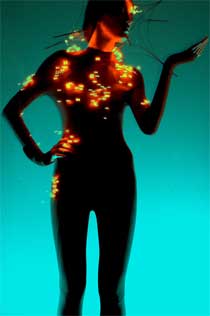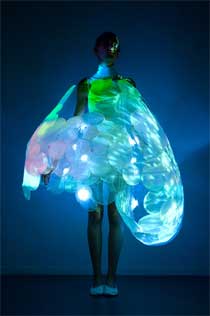 Still slowly sharing my notes from NEXT exhibition and conference. Tomorrow i’ll be in London. And when a man is tired of London, he blogs. So things might be even quieter than usual here!
Still slowly sharing my notes from NEXT exhibition and conference. Tomorrow i’ll be in London. And when a man is tired of London, he blogs. So things might be even quieter than usual here!
Lucy McRae is a “Body Architect.” Her work explores the intertwining of fashion, architecture and the human body. She’s currently focusing on the body’s reaction to and interaction with its environment at Philips Design in Eindhoven.
Her research is part of a programme that works 15 years ahead and identifies trends before they hit the mainstream.
Her latest project, SKIN Probe investigates the human skin, and how body products should be designed – be they garments, electronics or furniture. She developed it with a team made of people coming from different disciplines: a fashion designer, a textile engineer, a garment technologist, etc.
She listed a few phenomenons relevant to her research:
– Textile automation (clothing tailored just for you while you wait; DNA in your shoes);
– Health/Wellness (the need to relax for a society that passed from 5 working days per week to 7 thanks to glorious gadgets such as the Blackberry);
– Information overload (techno clutter still in search of the magical charger);
– miniaturizing and sensing;
– etc.
In her view, technology should be much more than just intelligent: it should be sensitive, thus able to give psycho-sensorial feedbacks (a subliminal message) and indirect response (touch and feel). She sees skin as a wonderful sensor: it’s an electronic network, a protection barrier, a temperature regulator, etc.
McRae also mentionned a EU project she’s currently working on. It’s called Stella and deals with stretcheable electronics, the advent of nano-scale sensors and how a combination of these two could allow our senses to become some kind of jewelry or a tattoo.

 Frisson and Blush Dress
Frisson and Blush Dress
She ended her talk with a few comments on the latest prototypes she developed for Philips:
– Frisson, a collaboration with Rachel Wingfield, investigates how sensations can be put into the objects that surround us. The body suit has LEDs that light on according to the wearer’s state of excitement. Both measure skin signals and change light emission through biometric sensing technology.
– The Blush Dress is less about touch and sensitivity and looks more at the environment that surrounds us. It is made of two layers, the inner one is equipped with sensors that respond to changes in the wearer’s emotions and projects them onto the outer textile.
Both prototypes belong to Philips’ Design Probe programme that considers what lifestyles might be like in 2020. They present a possible way of communicating with those around us by using garments as proxies to convey deep feelings that are difficult to express in words.
Note that Philips wasn’t the first to explore emotion and fashion. Artists have been doing that for years! Lisa Stead’s Emotional Wardrobe is a collection of garments that change their aesthetic display in response to the emotions of the wearer or the presence of a viewer; Scentient Beings by Jenny Tillotson created a fabric that interacts with human emotions and emits a selection of scents depending on your mood; Closer: Wearables for a distant society, by Alison Lewis aims at creating wearable interactive art which reinforces values of kindness, fun and play through touch, etc.
